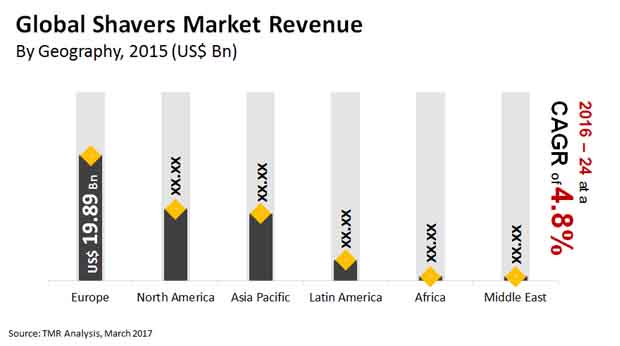
Global Shavers Market: Snapshot
The global market for shavers has been witnessing a significant rise in its valuation since the recent past, thanks to the increased focus of consumers on personal grooming. Nowadays, people across the world are more concerned about not just their face but their overall physical appearance, owing to which, they are prompted to shave body hair. The rising awareness pertaining to personal cleanliness and hygiene also has a remarkable contribution to this, which is reflecting greatly on the demand for various shaving products, leading to a substantial growth of the market for shavers, globally.
The escalating disposable income of consumers, enabling them to spend on expensive products, has been an important factor behind this phenomenal rise of this market and is expected to continue to aid the market over the forthcoming years. Females in developed countries have also surfaced as prominent consumers of shavers, which is also projected to influence the market further in the near future. However, the disinterest for personal grooming and the lack of knowledge concerning personal hygiene among women in emerging economies may affect the market’s progress to some extent over the next few years.
In 2015, the global market for shavers was worth US$46.38 bn. Rising at a healthy CAGR of 4.80% between 2016 and 2024, the opportunity in this market is likely to increase to US$70.24 bn by the end of 2024.
Purchase our Premium Research Report At:https://www.transparencymarketresearch.com/checkout.php?rep_id=21698<ype=S

Non-electric Shavers to Continue Attracting More Demand than Electric Ones
Electric and non-electric are the two main varieties of shavers available in the global market. Due to their user-friendly features and non-dependence on electricity or battery for operations, non-electric shavers have been more popular among consumers. In 2015, the non-electric shavers segment led this market with a share of 76.5%. Analysts project the segment to continue its leading steak over the next few years. Electric shavers, on the other hand, is exhibiting significant potential for future growth on the grounds of the increasing awareness among consumers pertaining to their efficiency.
General merchandising/mass stores, health and beauty stores, and supermarkets and hypermarkets are the key distribution channels of shavers across the world. As supermarkets and hypermarkets witness a relatively higher footfall and sell products in large quantities, they hold the most prominent share in the global market for shavers and are anticipated to retain their dominance over the forthcoming years.
Get More Press Releases by TMR: https://www.prnewswire.com/news-releases/accepted-benefits-of-increased-vehicle-safety-improved-overall-on-the-road-quality-to-extend-copious-growth-opportunities-for-automotive-digital-key-market-growth-projected-at-outstanding-21-5-cagr-from-2021–2031–tmr-301313826.html
Europe to Continue on Top Position
North America, Latin America, the Middle East, Europe, Africa, and Asia Pacific have surfaced as the prime regional segments of the worldwide market for shavers. Europe led this market with a share of nearly 43% in 2015. Thanks to the economic recovery in this region, which is instilling confidence among consumers to again shift to system razors and electric shavers, the Europe market for shavers is likely to continue on top in the years to come.
Among other regional markets, Asia Pacific and Latin America are expected to exhibit promising opportunities for growth in the near future, thanks to the rising urbanization and increase in consumers’ purchasing power.
Some of the leading players functional in the global market for shavers are Panasonic Corp., Koninklijke Philips N.V., Energizer Holdings Inc., Conair Corp., The Procter & Gamble Co., Spectrum Brands Holdings Inc., Super-Max Group, Wahl Clipper Corp., and SOCIÉTÉ BIC.
The EIRS quadrant framework in the report sums up our wide spectrum of data-driven research and advisory for CXOs to help them make better decisions for their businesses and stay as leaders.
To gauge the scope of customization in our reports, Ask for a Sample
Below is a snapshot of these quadrants.
1. Customer Experience Map
The study offers an in-depth assessment of various customers’ journeys pertinent to the market and its segments. It offers various customer impressions about the products and service use. The analysis takes a closer look at their pain points and fears across various customer touchpoints. The consultation and business intelligence solutions will help interested stakeholders, including CXOs, define customer experience maps tailored to their needs. This will help them aim at boosting customer engagement with their brands.
2. Insights and Tools
The various insights in the study are based on elaborate cycles of primary and secondary research the analysts engage with during the course of research. The analysts and expert advisors at TMR adopt industry-wide, quantitative customer insights tools and market projection methodologies to arrive at results, which makes them reliable. The study not just offers estimations and projections, but also an uncluttered evaluation of these figures on the market dynamics. These insights merge data-driven research framework with qualitative consultations for business owners, CXOs, policy makers, and investors. The insights will also help their customers overcome their fears.
3. Actionable Results
The findings presented in this study by TMR are an indispensable guide for meeting all business priorities, including mission-critical ones. The results when implemented have shown tangible benefits to business stakeholders and industry entities to boost their performance. The results are tailored to fit the individual strategic framework. The study also illustrates some of the recent case studies on solving various problems by companies they faced in their consolidation journey.
4. Strategic Frameworks
The study equips businesses and anyone interested in the market to frame broad strategic frameworks. This has become more important than ever, given the current uncertainty due to COVID-19. The study deliberates on consultations to overcome various such past disruptions and foresees new ones to boost the preparedness. The frameworks help businesses plan their strategic alignments for recovery from such disruptive trends. Further, analysts at TMR helps you break down the complex scenario and bring resiliency in uncertain times.
The report sheds light on various aspects and answers pertinent questions on the market. Some of the important ones are:
1. What can be the best investment choices for venturing into new product and service lines?
2. What value propositions should businesses aim at while making new research and development funding?
3. Which regulations will be most helpful for stakeholders to boost their supply chain network?
4. Which regions might see the demand maturing in certain segments in near future?
5. What are the some of the best cost optimization strategies with vendors that some well-entrenched players have gained success with?
6. Which are the key perspectives that the C-suite are leveraging to move businesses to new growth trajectory?
7. Which government regulations might challenge the status of key regional markets?
8. How will the emerging political and economic scenario affect opportunities in key growth areas?
9. What are some of the value-grab opportunities in various segments?
10. What will be the barrier to entry for new players in the market?
Note: Although care has been taken to maintain the highest levels of accuracy in TMR’s reports, recent market/vendor-specific changes may take time to reflect in the analysis.
Contact us:
Transparency Market Research
State Tower,
90 State Street, Suite 700,
Albany NY – 12207,
United States
Tel: +1-518-618-1030 Email: sales@transparencymarketresearch.com
Website: https://www.transparencymarketresearch.com
https://todaysmarkettrends.wordpress.com





